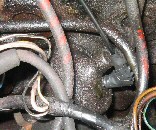Vacuum advance distributor pipe repair
Click on the images to enlarge
I was heading out to an important meeting when the Mini started to lose power and limped down the road finally coming to a stop. With gentle pressure on the accelerator pedal I could get it to move slowly, but anything more than this and it spluttered to a stand-still. This was not good, especially as I'd only allowed myself a few extra minutes for traffic in which to get to my meeting.
I pulled over, put on the mechanics gloves I always carry with my tool kit, and popped the bonnet to take a look.

It didn't take me long to locate the problem, I already had a vague idea as to what the problem might be, especially as it was happening when I tried to accelerate. Lifting the heat shield confirmed my suspicions.
There is a pipe that goes from the carburettor/inlet manifold to the distributor known as the vacuum advance distributor pipe. The pipe is made of plastic and the two end connectors are made of rubber. Over time and with exposure to high and low temperatures the rubber cracks, causing vacuum leak, which results in the vacuum advance distributor not working properly.
In my case the 90 degree L-shaped rubber connector that sits at the distributor end of the plastic pipe had split. As I only had a few minutes to carry out a quick repair, I opted for the tried and ed method of taping the rubber connector up with electricians tape, something else I always carry in my Mini's tool kit.
With the vacuum leak blocked, the Mini ran fine all the way to my meeting and back. When I got home I logged online to purchase a replacement. You can buy each end connector on it's own or as part of the complete pipe kit. The kit is always the better option because it proves to be far cheaper and you have spares left over.
On a whim I phoned my local car parts dealer and he had one in stock for pocket change, far less than the price that the on-line stores were selling them, and you don't have to pay for delivery. Bonus! I always find that for stock car parts you should always get a quote from a local store first to see if they are cheaper than on-line, leaving the on-line suppliers to provide you with the more specialist hard-to-get parts.

Now as far as these kits are concerned they all come with a plastic pipe and two rubber end connectors, one is L-shaped and the other is straight. However, for some reason my Mini has two L-shaped 90 degree bent rubber connectors at either end. I only needed the connector at the distributor end so I removed that from the new kit and kept the remaining bits as spares.
The Mini now runs great and I no longer have a taped-up rubber connector coming off my distributor.
Total cost of parts was less than the cost of a pint of beer!
Vacuum advance distributors
Ok, now for a footnote to this project entry. I wasn't content with finding and fixing this little problem, I wanted to know why my Mini spluttered to a halt by the side of the road just because a piece of rubber had split. As well as the enjoyment that comes with owning a Mini, this project is also about me learning a little more about how my Mini works. So I did a little light reading on vacuum advance distributors, and what I learned I've summarised below.
Modern cars have electronic control systems to help them fine tune an engine's ignition timing, but older engines like the Mini's A-series has to rely on mechanics and manifold vacuum.
At idle the distributor adjusts to achieve the best ignition timing, also known as the base advance. As the engine speed increases, weights and springs inside the distributor rotate and affect the timing advance (rotation speed being half engine RPM).
To improve fuel economy and driveability at low to medium speeds, a vacuum timing advance is used in conjunction with the mechanical timing advance. This is where a source of manifold vacuum is connected to the distributor to advance or retard the timing. This method is effectively supplying feedback to the distributor's sensor plate in regards to the current rate of airflow through the engine, indicating how much power the engine is currently generating, and therefore allowing the distributor to determine by how much it should advance or retard the current timing.
So when you put your foot down or brake, the distributor needs to know by how much you have increased or decreased the power in the engine so that it can alter the timing accordingly, as mechanical timing alone is just not good enough.
Thinking about it, it kind of explains why I could get the car to move slowly, but as soon I put my foot down, the engine lost power.
Did you enjoy this article or find the information useful? Help keep Dave and his articles online by keeping him fed with coffee by clicking the link below. Cheers!
This website uses cookies. Click here to learn more about how and why we use cookies.


